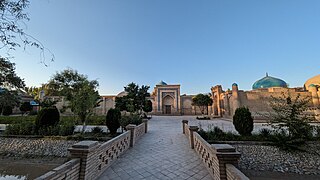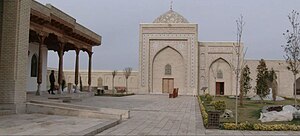
Qarshi is a city in southern Uzbekistan. It is the capital of Qashqadaryo Region. Administratively, Qarshi is a district-level city, that includes the urban-type settlement Qashqadaryo. It has a population of 278,300. It is about 520 km south-southwest of Tashkent, and about 335 km north of Uzbekistan's border with Afghanistan. It is located at latitude 38° 51' 48N; longitude 65° 47' 52E at an altitude of 374 meters. The city is important in natural gas production, but Qarshi is also famous for its production of woven flat carpets.

Qashqadaryo Region is one of the regions of Uzbekistan, located in the south-eastern part of the country in the basin of the river Qashqadaryo and on the western slopes of the Pamir-Alay mountains. It borders with Tajikistan, Turkmenistan, Samarqand Region, Bukhara Region and Surxondaryo Region. It covers an area of 28,570 km2. The population is an estimated 3,408,345 (2022), with 57% living in rural areas. The regional capital is Qarshi.
The Mirijanda Mausoleum is a cultural heritage object located in Uzbekistan. The object was built in the 5th–6th centuries. The mausoleum is located in the Mardtepa village, Gʻuzor District, Kashkadarya region. According to the property rights, it is state property. It was included in the national register of intangible cultural heritage objects by the decree of the Cabinet of Ministers of the Republic of Uzbekistan on October 4, 2019 - taken under state protection.
The Hazrati Bashir Mausoleum is a cultural heritage object located in Uzbekistan. The object was built in the 18th century. Hazrati Bashir mausoleum is located in the Bashir village of Kitob district, Qashqadaryo region. According to the rights of immovable property, it is considered state property on the basis of the operational management right of the Qashqadaryo region cultural heritage administration.

The Langar Ota Mausoleum is a cultural heritage site in Uzbekistan. It is located in the Kokbulok mahalla of Qamashi District of Qashqadaryo region, and was built in the 15th century. Currently, this area is under the operational management of the Kashkadarya Regional Department of Cultural Heritage. It is entrusted to the “Waqf” charity foundation on the basis of a free use agreement. The Langar Ota Mausoleum was included in the National Register of Immovable Cultural Heritage Objects by the decision of the Cabinet of Ministers of the Republic of Uzbekistan on October 4, 2019. The Langar Ota Mausoleum is under state protection.
Mubarak Mervazi Mausoleum is a cultural heritage object located in Uzbekistan, recognized as a significant historical site. The object was built in the 14th century and is situated in the "Sariqqishloq" neighborhood of the Muborak district in the Qashqadaryo region. According to the rights of non-residential property, it is considered state property, operated under the jurisdiction of the cultural heritage department of the Qashqadaryo region. It is designated as a state-owned property in accordance with the agreement for the use of the "Vaqf" charitable community fund. By the decision of the Cabinet of Ministers of the Republic of Uzbekistan on October 4, 2019, the immovable property objects of the tangible cultural heritage were included in the national list — they are under state protection.
Mausoleum of Hazrat Sultan is a memorial site located in the Shut village of the Koʻhsor neighborhood in the Kitob district of Qashqadaryo region, dating back to the 12th to 13th centuries. According to the rights of non-residential property, it is considered state property, operated under the jurisdiction of the cultural heritage department of the Qashqadaryo region. It is designated as a state-owned property in accordance with the agreement for the use of the "Vaqf" charitable community fund.
Sheikh Mavlon Complex is a historical object consisting of a mosque, a cemetery and a minaret, located near the old village of Qiyat, Khiva District Khorezm region. In the 19th century, a minaret, a mosque and a madrasah were built in this area, which was originally a cemetery, by order of Alla-Kuli-Khan. The cemetery, which is the foundation of the complex, contains the graves of Ogahi and his uncle, Shermuhammad Munis, a historian and translator who was a secretary in the Khiva Khanate. The complex is included in the UNESCO World Heritage List. At the moment, this complex is part of the Itchan Kala Museum-Reserve.
Yunuskhan Mausoleum is an architectural monument in the city of Khiva, Khorazm Region of the Republic of Uzbekistan. The mausoleum was built in 1559. Today, the mausoleum is located at 13, Pahlavon Mahmud street, Itchan Kala, next to the Pahlavon Mahmud complex.
Tugon Tura Mausoleum is an architectural monument in Khiva, Khorazm Region, Republic of Uzbekistan. The mausoleum dates back to the 19th century, and today it is located in the Yusuf Tashpulatov Street, "Itchan-Kala", Khiva. The object is a one-domed building located in a residential neighborhood to the north of the Toshhovli Palace.
Sheikh Kalandar Bobo Complex is an architectural monument in Khiva, Khorazm Region, Republic of Uzbekistan. The construction of the complex began in the 16th century and was completed in 1894. Today the complex is located at 36, Ismailov Street, "New Life" neighborhood.
Al-Beruni Architectural Complex is a complex located on Al-Khorazmi street, Urganch city, Khorazm Region. The complex was completed in 2000 at the initiative of former President of Uzbekistan Islam Karimov. The museum complex consists of a park with an area of 20 hectares.

Said Mahruyjan Complex is an architectural monument in the Khiva city, Khorazm Region of the Republic of Uzbekistan. The complex consists of a madrasa, a monastery, etc. built in 1884 around the tomb of Said Muhammad Mahruyjan. Today it is located at 84, Amir Temur Street, "Mevaston" neighborhood.
Al-Khwarizmi Complex is a complex consisting of a garden and a symbolic mausoleum located on Al-Khwarizmi street, Urganch, Khorazm Region, Uzbekistan. By the decision of the Cabinet of Ministers of the Republic of Uzbekistan on October 4, 2019, the complex was included in the national list of real estate objects of tangible cultural heritage and received state protection. Currently, it is state property based on the right of operational management of the Department of Culture of Khorazm Region.
Dashkin Bobo Complex is an architectural monument in Urganch, Khorazm Region. The complex was built in 1915, and today it is located at 43a, Yuldosh Bobojanov Street, Urganch. By the decision of the Cabinet of Ministers of the Republic of Uzbekistan on 4 October 2019, the complex was included in the national list of real estate objects of tangible cultural heritage and received state protection.

Khoja Kurban Madrasah is an architectural monument located in Darvozatutak neighborhood, Qarshi city, Qashqadaryo Region. The architectural monument was included in the national list of real estate objects of the material and cultural heritage of Uzbekistan in accordance with the decision of the President of the Republic of Uzbekistan dated December 19, 2018.
The Sharifboy Madrasa is one of the historical and cultural monuments located in Chaqar district of Qarshi city, Qashqadaryo Region. Sharifboy madrasa was included in the National Register of Immovable Property Objects of the Material and Cultural Heritage of Uzbekistan according to the Decree of the President of the Republic of Uzbekistan "On measures to radically improve the activities in the field of preservation of material and cultural heritage objects" dated December 19, 2018 No. PQ-4068 — taken under state protection.

Qarshi Bridge is an ancient brick bridge built over the Qashqadaryo River flowing through the territory of Qarshi city, connecting the two parts of the city. It is considered one of the symbols of the city of Qarshi. The construction of this bridge, which has reached so far, was carried out in the second half of the 16th century. Qarshi bridge is the largest bridge built over Qashqadaryo.

Kuk Gumbaz Mosque is an architectural monument in the city of Qarshi, Qashqadaryo Region, Uzbekistan. By the decision of the President of the Republic of Uzbekistan on 19 December 2018, the Khojash Mahram Madrasah was included in the national list of real estate objects of tangible cultural heritage and received state protection.

Chakar Mosque is an architectural monument located in Chakar MFY, Karshi city, Kashkadarya region. In accordance with the decision of the President of the Republic of Uzbekistan "On measures to fundamentally improve activities in the field of protection of tangible cultural heritage objects" dated December 19, 2018.








